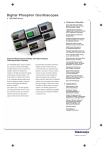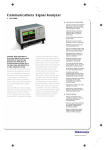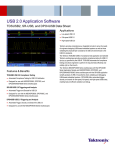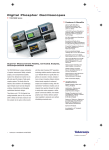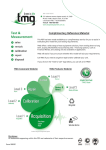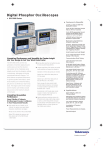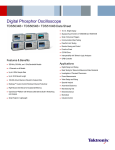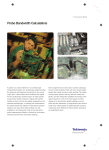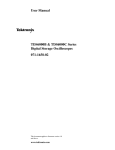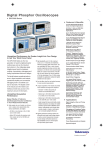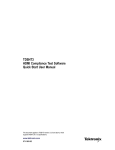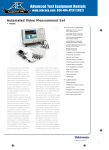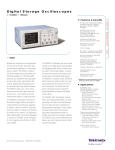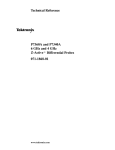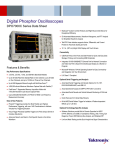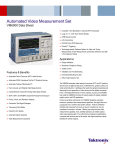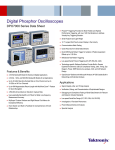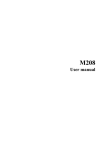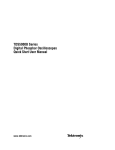Download File
Transcript
Digital Storage Oscilloscope TDS6000B/C Series Data Sheet Up to 64 Megasamples on Two Channels*1, up to 32 Megasamples Record Length on All Four Channels with MultiView Zoom™ Function for Quick Navigation MyScope® Custom-control Windows Enhance Productivity Right-mouse-click Menus for Exceptional Efficiency Pinpoint™ Triggering Provides the Most Flexible and Highest Performance Triggering, with Over 1400 Combinations to Address Virtually Any Triggering Situation Serial Pattern Triggering up to 3.125 Gb/s with 8b/10b Protocol Triggering Serial Data Analysis and Compliance at Rates of 6.25 Gb/s and Above OpenChoice® Software with Microsoft Windows XP OS Delivers Built-in Networking and Analysis Technology-specific Software Solutions Provide Built-in Domain Expertise for Serial Data, Jitter, Ethernet, DVI, USB 2.0, Communications, and Power Measurements System Includes: Dual-processor System (2.8 GHz Pentium 4 and 583 MHz PowerPC), High-resolution XGA Display, Front-panel CD-R/W, Front-panel USB 2.0 Port, and 1000BaseT Network Connection Features & Benefits Applications Signal Integrity, Jitter, and Timing Analysis Bandwidths of 15 GHz (TDS6154C), 12 GHz (TDS6124C), 8 GHz (TDS6804B), and 6 GHz (TDS6604B) Validation, Debug, Characterization, and Compliance of Next-generation Digital Designs Rise Times to 19 ps 20-80% (28 ps 10-90%) on TDS6154C Typical Rise Time, with Channel-matched, User-selectable DSP 40 GS/s Real-time Sample Rate on Two Channels*1, 20 GS/s Real-time Sample Rate on All Four Channels with 500 fs/sample Interpolated Points Computer, Datacom, Storage-area Network Equipment Designs, and High-speed Backplanes High-energy Physics Measurements and Data Acquisition *1 For C model versions only. Data Sheet Uncompromised Performance Oscilloscope Solution – Probing, Acquisition, Analysis, Compliance, and Debug TDS6000B/C Series digital storage oscilloscopes provide unprecedented performance along with a complete feature set designed to address design validation, debug, and compliance challenges of next-generation computer, datacom, and communications equipment. High bandwidth, high sample rate, and deep memory also provide the ideal solution for data acquisition applications. Uncompromised Acquisition You won’t need to need to trade off bandwidth, record length, and sample rate for your serial data measurement and analysis needs. The TDS6000C DSOs provides acquisition architecture with 40 GS/s maximum sample rate and 64 Megasamples record length on two channels (20 GS/s and 32 Megasamples on each of the four channels simultaneously), for the acquisition power you need. They provide the ultimate combination of bandwidth, sample rate, and record length for the fastest signals. The TDS6154C provides matched 15 GHz performance across any two channels using advanced, Tektronix-proprietary DSP enhancement, important for high-speed channel-channel measurements. The user-selectable DSP filter on each channel provides magnitude and phase correction, plus extension of the analog bandwidth to 15 GHz for more accurate signal fidelity on high-speed measurements – easily capturing the fifth harmonic of 3.0 GHz embedded clocks used in next-generation 6.0 Gb/s serial data standards, and even the third harmonic of 5 GHz clocks being developed for future systems. The DSP filter on each channel can also be switched off to take advantage of true 12 GHz analog bandwidth for applications needing the highest available raw data capture. MyScope® Custom-control Windows MyScope control windows allow you to build your own control windows with only the controls, features, and capabilities that you care about and are important in your job. For the first time you can create your own personalized “toolbox” of oscilloscope features. No longer do you need to 2 www.tektronix.com search through menus for features or relearn how to drive the oscilloscope after a break from the lab. MyScope control windows are easily created in a matter of minutes using a simple, visual, drag-and-drop process. Once created, these customized windows are easily accessed through a dedicated MyScope button and menu selection on the oscilloscope button/menu bar, just like any other control window. You can make an unlimited number of custom control windows, enabling each person who uses the oscilloscope, in a shared environment, to have their own unique control window. Since the control windows are stored as files on the hard drive, they can easily be transferred to other TDS5000B or TDS/CSA7000B Series oscilloscopes, or they can even be e-mailed to a coworker around the world when the need arises. MyScope control windows will benefit all oscilloscope users, from eliminating the ramp-up time that many face when returning to the lab after not using an oscilloscope for a while, to the power user who can now operate far more efficiently. Everything you need is found in one control window rather than having to constantly navigate through menu after menu to repeat similar tasks. Right Clicks Right-mouse-click menus make simple things as they should be – simple. Right-click menus are context sensitive, meaning the choices presented in the menu depend on where you right clicked the mouse. This makes right-click menus extremely intuitive. Want to change the cursor type? Right click on a cursor or the cursor readouts. Want to change the reference levels of an automatic measurement? Right click on the measurement. Want to change trigger parameters? Right click on the trigger readouts. Want to change a waveform’s color? Right click on the waveform handle. Virtually all objects on the oscilloscope display have right-click menus associated with them that include all the appropriate actions or features relative to those objects. There are also right-click menus for regions of the display in addition to just objects. For example, right clicking in the main graticule brings up a menu with choices such as Clear Data, Default Setup, Autoset, Screen Captures, Save All Waveforms, and Add Screen Text, providing single-click access to many of your most commonly performed tasks. Digital Storage Oscilloscope — TDS6000B/C Series Trigger on glitches down to 100 ps wide. Decode 8b/10b data streams and set up to 4 data words (40 bits) to trigger on. error, or need to isolate a section of a complex signal for further analysis, Tektronix’ Pinpoint triggering provides the solution. The Pinpoint trigger system uses Silicon Germanium (SiGe) technology to provide trigger sensitivity of up to 9 GHz (TDS6000C models), and allows selection of all trigger types on both A and B trigger circuits. It can capture glitches down to 100 ps wide with 1 psRMS trigger jitter typical (TDS6000C models). Other trigger systems offer multiple trigger types only on a single event (A Event), with delayed trigger (B Event) selection limited to edge-type triggering and often does not provide a way to reset the trigger sequence if the B Event doesn’t occur. But Pinpoint triggering provides the full suite of advance trigger types on both A and B triggers with Reset triggering to begin the trigger sequence again after a specified time, state, or transition so that even events in the most complex signals can be captured. Other oscilloscopes typically offer less than 20 trigger combinations; Pinpoint triggering offers over 1400 combinations, all at full performance. Protocol Triggering and Decoding Software (Opt. PTD) Pinpoint trigger system provides the most advanced, highest performance triggering available. Pinpoint™ Triggering The ability to trigger an oscilloscope on events of interest is paramount in high-speed debug and validation. Whether you’re trying to find a system Easily decode 8b/10b and other encoded serial data streams, and set desired encoded words for the serial pattern trigger to capture. 8b/10b decoding on data rates over 10 GB/s is possible on the TDS6000C models. Option PTD recovers the clock signal, identifies the transitions, and decodes the characters and other protocol data. The TDS6000C models can trigger on up to four consecutive 10 bit words or specified error conditions at data rates up to 3.125 Gb/s. And you can see the captured bit sequences decoded into their words for convenient analysis. www.tektronix.com 3 Data Sheet Measurement System. Enables over 50 parametric measurements in the amplitude, time, and statistical domain. 8.5 Gb/s TDSRT-Eye™ diagram on the TDS6154C. Unparalleled Analysis Waveform data analysis can take many forms. Whether it’s a simple math expression, waveform mask testing, a pass/fail compliance test, or a custom application that you develop, the TDS6000B/C Series offer the industry’s most comprehensive set of analysis and compliance tools. Built-in Analysis Tools Standard tools built into the TDS6000B/C offer a wide range of analysis capabilities including Cursors, Measurements, Math Equation Editor, 4 www.tektronix.com Waveform Math Equation Editor. Enables boundless analysis on waveform data. Serial Data Communications Mask Testing (with Opt. SM), and Spectrum Analysis. Digital Storage Oscilloscope — TDS6000B/C Series TDSRT-Eye™ software. Compliance and analysis for testing high-speed serial standards. Eye diagrams at data rates to beyond 6.25 Gb/s. Software clock recovery to ≥10 Gb/s. TDSET3 10/100/1000BaseT Compliance. TDSJIT3 v2.0 Jitter analysis for validation and debug of high-speed digital systems. TDSDVI Digital Visual Interface Compliance. Technology-specific Software Solutions TDS6000B/C models provide complete “turn-key” solutions for the most demanding technologies. Software options are also available for performing validation and compliance measurements on emerging industry standards. Validation, debug, and compliance testing often require automated test tools that quickly analyze waveform data and provide the answers you need. The www.tektronix.com 5 Data Sheet Access data seamlessly for your own custom application such as this Microsoft Excel example. OpenChoice® Analysis Designing your own custom solution? The analysis and networking features of OpenChoice software adds more flexibility to Tektronix open Windows XP oscilloscopes: Fast PCI bus speeds communication between the data acquisition processor and the Microsoft Windows desktop. ActiveX controls to connect the oscilloscope to popular Windows applications - WITHOUT leaving the application. PnP drivers to control the scope from LabVIEW and Lab Windows/CVI running directly on the oscilloscope, or running on external PCs. Support for application development environments includes Visual BASIC, .NET, C, C++, MATLAB, LabVIEW, and LabWindows/CVI. 6 www.tektronix.com P7313 12.5 GHz and P7380 8 GHz Differential Probes. Differential Probing with Performance to >12 GHz Most high-speed signals today are differential. The P7313 12.5 GHz Differential Probing System provides true differential connection to the device under test for a variety of connection requirements: solder-in, hand held, and fixtured. Typical system performance with the TDS6154C exceeds 12.5 GHz bandwidth. The P7313 offers the lowest loading, highest signal fidelity, and lowest cost per connection in the industry. Versatile, inexpensive Tip-Clip™ adapters provide the optimum solution for virtually any connection need. The P7380SMA Differential Probing System provides a 50 Ω per side termination network with a termination voltage. The termination voltage can be applied externally or through the TekConnect® interface from the TDS6000B/C probe menu, or not used at all. A gain switch provides two different sensitivity settings of the probe and an Aux Out provides an inverted version of the signal for driving other equipment. The P7380SMA probing system used with the TDS6000B/C oscilloscopes provides an ideal solution for validation and compliance testing of high-speed serial data links. Digital Storage Oscilloscope — TDS6000B/C Series Characteristics Vertical System Characteristic TDS6604B TDS6804B TDS6124C TDS6154C 12 GHz 35 ps (10-90%) (typical) 24 ps (20-80%) (typical) 12 GHz 35 ps (10-90%) (typical) 24 ps (20-80%) (typical) 20 MHz 15 GHz 28 ps (10-90%) (typical) 19 ps (20-80%) (typical) 12 GHz 35 ps (10-90%) (typical) 24 ps (20-80%) (typical) 4 Input Channels Bandwidth, Rise Time (DSP) N/A True Analog Bandwidth (-3 dB), typical Rise Time 6 GHz 70 ps (10-90%) (typical) 53 ps (20-80%) (typical) Hardware Bandwidth Limits (Requires TCA-1MEG Adapter) Input Coupling Input Impedance Input Sensitivity, 50 Ω 8 GHz 50 ps (10-90%) (typical) 35 ps (20-80%) (typical) 7 GHz 62 ps (10-90%) (typical) 43 ps (20-80%) (typical) Full, 250 MHz, or DC, GND 50 Ω ±2.5% 50 Ω ±2% Full-scale 50 mV to 10 V (5 mV/div*2 to 1 V/div). Full-scale is the peak-peak digitizer range at a given sensitivity. V/div = Full-scale/10. 8 bit (>11 bit with averaging) <1 VRMS for <100 mV/div, <1 VRMS for <1 V full-scale, <7 VRMS for ≥100 mV/div settings. <5.5 V for ≥1 V full-scale. Vertical Resolution Max Input Voltage, 50 Ω (Also determined by TekConnect® accessory) DC Gain Accuracy Position Range Offset Range*3 ±(2.5% + (2% × offset)) ±2% ±5 divisions Full-scale settings: 100 mV: ±0.45 V 200 mV: ±0.4 V 500 mV: ±0.25 V 1 V: ±4.5 V 2 V: ±4.0 V 5 V: ±2.5 V 10 V: 0 General formula for offset range: 100 mV to 995 mV: ±|0.5 V - Full-scale/2| 1 V to 10 V: ±|5 V - Full-scale/2| ±(0.35% × offset + 1.5 mV + 0.1 × V/div setting) for ranges <100 mV/div ±(0.35% × offset + 15 mV + 0.1 × V/div setting) for ranges ≥100 mV/div ≥150:1 at 0 to 10 GHz >80:1 at 10 GHz to 12 GHz ≥50:1 at 12 GHz to 15 GHz Full-scale settings: 100 mV to 500 mV: ±0.5 V 505 mV to 995 mV: ±0.25 V 1 V to 5 V: ±5 V 5.05 V to 10 V: ±2.5 V Offset Accuracy ±(0.7% × offset + 1.5 mV + 0.1 × V/div setting) for ranges <100 mV/div ±(0.8% × offset + 15 mV + 0.1 × V/div setting) for ranges ≥100 mV/div ≥80:1 at 1.5 GHz ≥15:1 at rated bandwidth Channel-to-Channel Isolation for Any Two Channels at Equal Vertical Scale *2 5 mV/div is a software zoom with 7 bits digitizer resolution at 50 mV full scale. *3 Offset range in addition to ±5 division position range. Vertical System (Cont.) Characteristic Noise, typical Full-scale Gain Setting TDS6000B DSP OFF TDS6154C DSP ON TDS6124C DSP ON BOTH DSP OFF 100 mV 160 mV 200 mV 300 mV 400 mV 500 mV 800 mV 900 mV 1V 2V 5V 10 V 950 μV – 690 μV 950 μV 1.1 mV 1.6 mV 2.1 mV 2.5 mV 4.4 mV 4.8 mV 6.9 mV 10.5 mV 25 mV 56 mV 570 μV 840 μV 940 μV 1.45 mV 1.85 mV 2.3 mV 3.8 mV 4.3 mV 5.7 mV 9.5 mV 23 mV 46 mV 670 μV 950 μV 1.0 mV 1.6 mV 2.1 mV 2.4 mV 4.1 mV 4.6 mV 6.8 mV 10.0 mV 24 mV 50 mV 1.6 mV – – 3.55 mV – – 9.5 mV 16 mV 35.5 mV 68 mV www.tektronix.com 7 Data Sheet Timebase System Characteristic Timebase Range Timebase Delay Time Range Channel-to-Channel Deskew Range Trigger Jitter (RMS) Long-term Sample Rate and Delay Time Accuracy Clock Stability Jitter Noise Floor Delta Time Accuracy Acquisition Modes TDS6000B Models TDS6000C Models 25 ps to 40 s/div; Interpolation down to 500 fs/pt. 5 ns to 250 s ±75 ns <1.5 psRMS (typical) <1 psRMS (typical) <2 ppm over any ≥100 ms interval <1 ppm (typical) <2.5 ppm (guaranteed) 420 fsRMS (typical) over 10 µs duration or less 635 fsRMS over <100 ns [(0.06/sample rate) + duration, typical*5 (2.5 ppm × [Reading])]RMS, typical*4 Mode All Models Waveform Database Accumulate Waveform Database providing three-dimensional array of amplitude, time, and counts Acquire sampled values Captures narrow glitches at all real-time sampling rates 50 ps Sample Peak Detect Minimum Peak Detect Pulse Width Averaging Envelope Hi-Res FastFrame™ Acquisition Roll Mode *4 Test conditions: Sample mode, at 20 GS/s. *5 Test conditions: Sample mode, 500 mV full-scale (50 mV/div) setting, input signal 350 mV with rise time (10% to 90%) <50 ps. Characteristic TDS6000B Models Max Sample Rate 20 GS/s on 4 channels Equivalent Time Sample Rate (max) Maximum Record Length per Channel TDS6000C Models 40 GS/s on 2 channels, 20 GS/s on 4 channels 2 TS/s 32 M (requires Opt. 4M) Standard 2 M on all 4 channels with Memory Opt. 2M 8 M on all 4 channels with Memory Opt. 3M 16 M on all 4 channels with Memory Opt. 4M 32 M on all 4 channels 64 M on two channels; 32 M on all 4 channels (requires Opt. 4M) 4 M on two channels; 2 M on all 4 channels 16 M on two channels; 8 M on all 4 channels 32 M on two channels; 16 M on all 4 channels 64 M on two channels; 32 M on all 4 channels Maximum Time Duration Captured at Highest Real-time Resolution (All Channels) Characteristic Max Duration with Standard Memory Max Duration with Opt. 2M Max Duration with Opt. 3M Max Duration with Opt. 4M Pinpoint™ Trigger System Characteristic Acquisition System TDS6000B Models (All Channels) TDS6000C Models (Two Channels) 100 μs 100 μs 400 μs 800 μs 1.6 ms 400 μs 800 μs 1.6 ms From 2 to 10,000 waveforms included in average From 2 to 2×109 waveforms included in min-max envelope Real-time boxcar averaging reduces random noise and increases resolution Acquisition memory divided into segments; maximum trigger rate >310,000 waveforms per second. Time of arrival recorded with each event 200 kS/s at 8 M record length and 500 kS/s at 4 M record Length on all channels. All Models Sensitivity Internal DC Coupled External (auxiliary input) 0.5 div DC to 50 MHz increasing to 2.5 div at 7 GHz (TDS6000B models, typical). 0.4 div DC to 50 MHz , increasing to 1 div at 3 GHz, increasing to 3 div at 9 GHz (TDS6000C models, typical). 250 mVDC to 50 MHz, increasing to 350 mV at 1 GHz, increasing to 500 mV at 2 GHz (typical). Trigger Characteristics Main Trigger Modes A Event and Delayed B Event Trigger Types Trigger Sequences Communications-related Triggers (requires Opt. SM) Serial Pattern Trigger (requires Opt. ST) Auto, Normal, and Single. Edge, Glitch, Runt, Width, Transition Time, Timeout, Pattern, State, Setup/Hold, Window – all except Edge, Pattern, and State can be Logic State qualified by up to two channels. Main, Delayed by Time, Delayed by Events, Reset by Time, Reset by State, Reset by Transition. All sequences can include separate horizontal delay after the trigger event to position the acquisition window in time. Support for AMI, HDB3, BnZS, CMI, MLT3, and NRZ encoded communications signals up to 3.125 Gb/s. Select among isolated positive or negative one, zero pulse form, or eye patterns as applicable to standard. 64 bit serial word recognizer, bits specified in binary (high, low, don’t care) or hex format. Trigger on NRZ-encoded data up to 1.25 Gbaud. TDS6000C models only: trigger on 8b/10b encoded data up to 3.125 Gbaud (40 bits). Trigger Level Range Internal External (auxiliary in) Line Trigger Coupling Trigger Holdoff Range 8 www.tektronix.com ±12 divisions from center of screen. ±5 V. Fixed at 0 V. DC, AC (attenuate <60 Hz). HF reject (attenuate >30 kHz). LF reject (attenuates <80 kHz). Noise reject (reduce sensitivity). 250 ns minimum to 12 s maximum. Digital Storage Oscilloscope — TDS6000B/C Series Trigger Types Computer System and Peripherals Edge – Positive and/or negative slope on any channel or front-panel auxiliary input. CPU – Intel Pentium 4 processor, 2.8 GHz. Coupling includes DC, AC, noise reject, HF reject, and LF reject. Glitch – Trigger on or reject glitches of positive, negative, or either polarity. Minimum glitch width is down to 100 ps with re-arm time of 250 ps. Width – Trigger on width of positive or negative pulse (down to 100 ps) either within or out of selectable time limits. Runt – Trigger on a pulse that crosses one threshold but fails to cross a second threshold before crossing the first again. Optional time qualification. Timeout – Trigger on an event which remains high, low, or either, for a specified time period, selectable from 360 ps to 1 s. Transition – Trigger on pulse edge rates that are faster or slower than specified. Slope may be positive, negative, or either. Setup/Hold – Trigger on violations of both setup time and hold time between clock and data present on any two input channels. Pattern – Trigger when pattern goes false or stays true for specified period of time. Pattern (AND, OR, NAND, NOR) specified for four input channels defined as HIGH, LOW, or Don’t Care. State – Any logical pattern of channels (1, 2, 3) clocked by edge on channel 4. Trigger on rising or falling clock edge. Window – Trigger on an event that enters or exits a window defined by two user-adjustable thresholds. Event can be time or logic qualified. Trigger Delay by Time – 5 ns to 250 seconds. Trigger Delay by Events – 1 to 10,000,000 events. Waveform Measurements Amplitude – Amplitude, High, Low, Maximum, Minimum, Peak-to-Peak, Mean, Cycle Mean, RMS, Cycle RMS, Positive Overshoot, Negative Overshoot. Time – Rise time, Fall time, Positive Width, Negative Width, Positive Duty Cycle, Negative Duty Cycle, Period, Frequency, Delay. Combination – Area, Cycle Area, Phase, Burst Width. Histogram-related – Waveform count, Hits in box, Peak hits, Median, Maximum, Minimum, Peak-to-Peak, Mean (μ), Standard Deviation (σ), μ + 1σ, μ + 2σ, μ + 3σ. Eye-pattern-related – Extinction Ratio (absolute, %, and dB), Eye Height, Eye Top, Eye Base, Eye Width, Crossing %, Jitter (peak-peak, RMS, and 6sigma), Noise (peak-peak and RMS), S/N ratio, Cycle Distortion, Q-factor. Waveform Processing/Math Algebraic Expressions – Define extensive algebraic expressions including waveforms, scalars, and results of parametric measurements e.g. (Integral (CH.1-Mean(CH.1))×1.414). Arithmetic – Add, subtract, multiply, divide waveforms and scalars. Relational – Boolean result of comparison >, <, ≥, ≤, =, ≠. Calculus – Integrate, differentiate. Frequency Domain Functions – Spectral magnitude and phase, real and imaginary spectra. Vertical Units – Magnitude: Linear, dB, dBm. Phase: Degrees, Radians. Window Functions – Rectangular, Hamming, Hanning, Kaiser-Bessel, Blackman-Harris, Gaussian, Flattop2, Tek Exponential. Waveform Definition – As arbitrary math expressions. Display Characteristics Display Type – Liquid-crystal active-matrix color display. Display Size – Diagonal: 264 mm (10.4 in.). Display Resolution – 1024 horizontal × 768 vertical pixels. Waveform Styles – Vectors, Dots, Variable Persistence, Infinite Persistence. PC System RAM – 1 GB (266 MHz DDR). Hard Disk Drive – 40 GB removable hard disk drive: rear-panel standard or front-panel (Opt. FHD). USB Ports – One on front panel, four on rear panel, USB 2.0 compliant. CD-R/W Drive – Front-panel CD-R/W standard or rear-panel (Opt. FHD). Mouse – Optical scroll-wheel model included, USB interface. Keyboard – Small keyboard included (fits in pouch). Order 119-6297-xx for full-size keyboard; USB interface and hub. Input/Output Ports Front Panel Fast Edge Output – Front-panel SMA connector provides fast edge signal. TDS6000B models: Amplitude 350 mV ±20% into a ≥50 Ω load, frequency 1 kHz ±5%, 200 ps typical rise time. TDS6000C models: Amplitude 440 mVpk-pk, ±20% in a 50 Ω load; VOH +0.3 V, VOL - 0.14 V; frequency 1 kHz ±5%, 200 ps typical rise time. Recovered Clock – SMA connector, ≤1.25 Gb/s, Output swing ≥130 mVpk-pk into 50 Ω. Requires Opt. SM or Opt. ST to enable. Recovered Data – SMA connector, ≤1.25 Gb/s, Output swing of 1010 repeating pattern 200 mV into 50 Ω. Requires Opt. SM or Opt. ST to enable. DC Probe Calibration Output – BNC connector, ±10 VDC for DC probe calibration. (Signal available only during probe calibration.) AUX Trigger Output – BNC connector, provides a TTL-compatible, polarity switchable pulse when the oscilloscope triggers. USB 2.0 Port – One in front. Allows connection or disconnection of USB keyboard, mouse, or storage device while oscilloscope is on. Rear Panel External Timebase Reference In – BNC connector; allows timebase system to phase-lock to external 10 MHz reference. Timebase Reference Out – BNC connector; provides TTL-compatible output of internal 10 MHz reference oscillator. Aux Trigger Input – BNC, see Ext Trigger specification. Parallel Port – IEEE 1284, DB-25 connector. Audio Ports – Miniature phone jacks for stereo microphone input and stereo line output. USB 2.0 Ports – Four in back. Allows connection or disconnection of USB keyboard, mouse, or storage device while oscilloscope power is on. Keyboard Port – PS-2 compatible. Mouse Port – PS-2 compatible. LAN Port – RJ-45 connector, supports 10BaseT, 100BaseT, and 1000BaseT. Serial Port – DB-9 COM1 port. Windows Video Port – 15-pin D-Sub connector on the rear panel; connect a second monitor to use dual-monitor display mode allowing analysis results and plots to be viewed along with the oscilloscope display. Video is DDC2B compliant. GPIB Port – IEEE 488.2 standard. Scope XGA Video Port – 15-pin D-Sub connector on the rear panel, video is IBM XGA compatible. Connect to show the oscilloscope display, including live waveforms on an external monitor or projector. The primary Windows desktop can also be displayed on an external monitor using this port. www.tektronix.com 9 Data Sheet Power Source Humidity Power – 100 to 240 VRMS, ±10%, 50/60 Hz; 115 VRMS ±10%, 400 Hz; CAT II, <500 W Operating – 20% to 80% relative humidity with a maximum wet-bulb temperature of +29 °C at or below +50 °C, noncondensing. Upper limit derated to 25% relative humidity at +50 °C. typical (650 VA). Option SM Nonoperating – 5% to 90% relative humidity with a maximum wet-bulb temperature 156 Standards Masks Supported – ITU-T (1.544 Mb/s - 155 Mb/s) ANSI T1.102 (1.544 Mb/s - 155 Mb/s) Ethernet IEEE Std 802.3, ANSI X3.263 (1.544 Mb/s - 3.125 Gb/s XAUI) Sonet/SDH (51.84 Mb/s - 2.4883 Gb/s) Fibre Channel (133 Mb/s - 4.25 Gb/s*6) InfiniBand (2.5 Gb/s) USB (12 Mb/s - 480 Mb/s) Serial ATA (1.5 Gb/s, 3.0 Gb/s) Serial Attached SCSI (1.5 Gb/s, 3.0 Gb/s) IEEE 1394b (491.5 Mb/s - 1.966 Gb/s) Rapid I/O (1.25 Gb/s - 3.125 Gb/s) OIF Standards (2.488 Gb/s - 3.11 Gb/s) PCI Express (2.5 Gb/s) *6 4.25 Gb/s mask supported using Glitch Trigger. of +29 °C at or below +60 °C, noncondensing. Upper limit derated to 20% relative humidity at +60 °C. Altitude Operating – 10,000 ft. (3,048 m). Nonoperating – 40,000 ft. (12,190 m). Random Vibration Operating – 0.000125 g2/Hz from 5 to 350 Hz, -3 dB/octave from 350 to 500 Hz, 0.0000876 g2/Hz at 500 Hz. Overall level of 0.24 gRMS. Nonoperating – 0.0175 g2/Hz from 5 to 100 Hz, -3 dB/octave from 100 to 200 Hz, 0.00875 g2/Hz from 200 to 350 Hz, -3 dB/octave from 350 to 500 Hz, 0.006132 g2/Hz at 500 Hz. Overall level of 2.28 gRMS. Certifications Physical Characteristics Electromagnetic Compatibility – 89/336/EEC. Benchtop Configuration Safety – UL 3111-1, CSA1010.1, EN61010-1, IEC 61010-1. Dimensions mm in. Height Width Depth 282 457 540 11.1 18.0 23.25 Weight kg lb. Net Shipping 21 32.3 47 71.2 Dimensions mm in. Height Width Depth 267 491 638 10.5 19.3 25.1 TDS6804B Weight kg lb. 6 GHz Digital Storage Oscilloscope. Net Kit 22 5.6 49 12.25 mm in. 0 or >76 25 76 76 0 0 0 or >3 1 3 3 0 0 Rackmount Configuration Top Bottom Left side Right side Front Rear Environmental Temperature Operating – Excluding CD-R/W drive: TDS6000B models: +5 °C to +40 °C. TDS6000C models: +10 ºC to +45 ºC. Including CD-R/W drive: +10 °C to +40 °C. Nonoperating – -22 °C to +60 °C. 10 www.tektronix.com TDS6154C 15 GHz Digital Storage Oscilloscope. TDS6124C 12 GHz Digital Storage Oscilloscope. Mechanical Cooling Required Clearance Ordering Information 8 GHz Digital Storage Oscilloscope. TDS6604B TDS6000B and TDS6000C Models Include: Accessory pouch, front cover, USB mouse, USB mini-keyboard, user manual (071-1658-xx), Documentation CD-ROM (063-3760-xx), product software CD-ROM (020-2572-xx for TDS6000B models; 020-2647-xx for TDS6000C models), operating system restoration CD-ROM (020-2569-xx), optional applications software CD-ROM (020-2450-xx), performance verification procedure PDF file, GPIB programmer’s reference (on product software CD-ROM), calibration certificate documenting NIST traceability, 2 540-1 compliance and ISO9000, power cord, one-year warranty. (4) TekConnect® to SMA adapters (TCA-SMA) , Deskew Fixture (067-0484-xx). Please specify power plug when ordering. Instrument Options Power Plug Options Opt. A0 – North America power. Opt. A1 – Universal EURO power. Opt. A2 – United Kingdom power. Opt. A3 – Australia power. Opt. A5 – Switzerland power. Opt. A6 – Japan power. Opt. A10 – China power. Opt. A99 – No power cord or AC adapter. Digital Storage Oscilloscope — TDS6000B/C Series Manual Language Options Opt. L5 – Japanese manual Opt. L7 – Simplified Chinese manual Opt. L10 – Russian manual Disk Drive Options Opt. FHD – Front-panel 40 GB removable hard disk drive, replaces front-panel CD-R/W which is moved to the back. Cables GPIB Cable (1 m) – Order 012-0991-01. GPIB Cable (2 m) – Order 012-0991-xx. RS-232 Cable – Order 012-1298-xx. Centronics Cable – Order 012-1214-xx. Mounting Options Opt. 1K – K4000 Scope Cart. Opt. 1R – Rackmount Kit. Service Options Opt. C3 – Calibration Service 3 Years. Opt. C5 – Calibration Service 5 Years. Opt. D1 – Calibration Data Report. Opt. D3 – Calibration Data Report 3 Years (requires Opt. C3). Opt. D5 – Calibration Data Report 5 Years (with Opt. C5). Opt. R3 – Repair Service 3 Years. Opt. R5 – Repair Service 5 Years. Acquisition Memory Options TDS6000B Models: Opt. 2M – 8 MSamples on all channels. Opt. 3M – 16 MSamples on all channels. Opt. 4M – 32 MSamples on all channels. TDS6000C Models: Opt. 2M – 16 MSamples on two channels; 8 MSamples on all channels. Opt. 3M – 32 MSamples on two channels; 16 MSamples on all channels. Opt. 4M – 64 MSamples on two channels; 32 MSamples on all channels. Software Options Opt. CP2*7 – TDSCPM2 ANSI/ITU Telecom Pulse Compliance Testing Software (requires Opt. SM). Opt. DVI – TDSDVI DVI Compliance Test Solution. Opt. ET3 – TDSET3 Ethernet Compliance Test Software. Opt. HT3 – HDMI Compliance Test Software. Opt. JA3 – TDSJIT3 v2.0 Advanced Jitter Analysis Software. Opt. JE3 – TDSJIT3 v2.0 Essentials Jitter Analysis Software. Opt. J2 – TDSDDM2 Disk Drive Analysis Software. Opt. PW3*8 – TDSPWR3 Power Measurement and Analysis Software. Opt. RTE – TDSRT-Eye™ Serial data compliance and analysis software. Opt. RJA – Software Bundle of TDSJIT3 v2.0 (Opt. J3A), TDSRT-Eye (Opt. RTE), and Protocol Trigger Decode (Opt. PTD). Opt. RSA – Software Bundle of TDSJIT3 v2.0 (Opt. J3A), RT-Eye (Opt. RTE), Serial Trigger (Opt. ST), Protocol Trigger and Decode (Opt. PTD), and Serial Mask testing (Opt. SM). Opt. PCE*9 – PCI Express™ Compliance Module for Opt. RTE. Opt. PTD – Protocol Trigger and Decode (provides protocol decode on all models, requires Opt. ST for protocol triggering on the TDS6000C Series only). Opt. IBA*9 – InfiniBand® Compliance Module for Opt. RTE. Opt. SM – Serial Communications Mask Testing (enables hardware clock recovery). Opt. SST – SATA and SAS Analysis Software Module for Opt. RTE. Opt. ST – Serial Pattern Trigger (enables hardware clock recovery) Opt. USB*10 – TDSUSBS USB 2.0 Compliance Test SW Only. Recommended Accessories P7313 – 12.5 GHz Differential Probe. P7380 – 8 GHz Differential Probe. P7380SMA – 8 GHz Differential Probing System. AFTDS – Telecom Differential Electrical Interface Adapter (for line rates < 8 MB/sec; requires TCA-BNC adapter). Keyboard (USB interface) Full-size Keyboard with 4-port USB hub – Order 119-6297-xx. Transit Case – Order 016-1942-xx. TekConnect® Adapters – TCA-1MEG: TekConnect® High-impedance Buffer Amplifier. Includes P6139A Passive Probe. TCA-SMA: TekConnect-to-SMA Adapter. TCA-N: TekConnect-to-N Adapter. TCA-BNC: TekConnect-to-BNC Adapter. TCA75: 4 GHz precision TekConnect® 75 Ωto 50 ΩAdapter with 75 ΩBNC Input Connector. Oscilloscope Cart – Order K4000. Software – WSTRO: WaveStar™ Waveform Capture and Documentation Software. Test Fixtures – TDSUSBF: TDSUSB Test Fixture for use with Opt. USB. After Purchase Upgrades of TDS6000B and TDS6000C Series Oscilloscopes To upgrade your oscilloscope, order option as noted. Acquisition Record Length Current Record Length Standard 8 MSamples 16 MSamples Desired Order 8 MSamples (16 MSamples TDS6000C) 16 MSamples (32 MSamples TDS6000C) 32 MSamples (64 MSamples TDS6000C) 16 MSamples (32 MSamples TDS6000C) 32 MSamples (64 MSamples TDS6000C) 32 MSamples (64 MSamples TDS6000C) TDS6BUP Opt. M02 TDS6BUP Opt. M03 TDS6BUP Opt. M04 TDS6BUP Opt. M23 TDS6BUP Opt. M24 TDS6BUP Opt. M34 *7 Requires Opt. SM. *8 Opt. 3M and a TCA-1MEG TekConnect 1 MΩ buffer amplifier are recommended for use with this software. *9 Requires Opt. RTE (Serial Data Compliance and Analysis). *10 Requires TDSUSBF (USB Test Fixture). www.tektronix.com 11 Data Sheet Contact Tektronix: ASEAN / Australasia (65) 6356 3900 Austria +41 52 675 3777 Balkans, Israel, South Africa and other ISE Countries +41 52 675 3777 Belgium 07 81 60166 Description Order TDS6BUP Opt. SM TDS6BUP Opt. ST Included in Opt. SM and ST Brazil +55 (11) 40669400 Serial Comm Mask Testing Serial Pattern Trigger Hardware Clock Recovery for Serial Data Stream Canada 1 (800) 661-5625 Central East Europe, Ukraine, and the Baltics +41 52 675 3777 Central Europe & Greece +41 52 675 3777 Analysis and Compliance Software TDS6BUP Opt. CP2 (Requires Opt. SM) TDS6BUP Opt. DVI TDS6BUP Opt. ET3 TDS6BUP Opt. JA3 TDS6BUP Opt JE3 TDS6BUP Opt. J2 TDS6BUP Opt. PW3 TDS6BUP Opt PTD Denmark +45 80 88 1401 ANSI/ITU Telecom Pulse Compliance Finland +41 52 675 3777 France +33 (0) 1 69 86 81 81 DVI Compliance Test Ethernet Compliance JIT3 V2.0 Advanced Jitter Analysis Software JIT3 V2.0 Essentials Jitter Analysis Software DDM2 Disk Drive Analysis Software Power Measurement/Analysis Protocol Trigger and Decode (trigger capability for TDS6000C only, requires Opt. ST) RT-Eye Serial Data Compliance and Analysis Software PCI Express™ Compliance Module for Opt. RTE Germany +49 (221) 94 77 400 Hong Kong (852) 2585-6688 India (91) 80-42922600 Italy +39 (02) 25086 1 Japan 81 (3) 6714-3010 Luxembourg +44 (0) 1344 392400 Mexico, Central/South America & Caribbean 52 (55) 54247900 Middle East, Asia, and North Africa +41 52 675 3777 TDS6BUP Opt RTE TDS6BUP Opt PCE (Requires Opt. RTE or RJA or RSA) InfiniBand® Compliance Module for Opt. RTE TDS6BUP Opt IBA (Requires Opt. RTE or RJA or RSA) USB 2.0 Compliance, Software Only TDS6BUP Opt. USB (Requires TDSUSBF test fixture) TDS6BUP Opt. RJA RT-Eye Serial Data Analysis Software, TDSJIT3 v2.0 Advanced Jitter Analysis, Opt. PTD Protocol Trigger and Decode Software Bundle TDS6BUP Opt. RSA RT-Eye Serial Data Analysis, TDSJIT3 v2.0 Advanced Jitter Analysis, Opt. SM Serial Mask, Opt. ST Serial Trigger, Opt. PTD Protocol Trigger and Decode Software Bundle The Netherlands 090 02 021797 Norway 800 16098 People’s Republic of China 86 (10) 6235 1230 Poland +41 52 675 3777 Portugal 80 08 12370 Republic of Korea 82 (2) 6917-5000 Russia & CIS +7 (495) 7484900 South Africa +27 11 206 8360 Spain (+34) 901 988 054 Sweden 020 08 80371 Switzerland +41 52 675 3777 Taiwan 886 (2) 2722-9622 United Kingdom & Ireland +44 (0) 1344 392400 USA 1 (800) 426-2200 For other areas contact Tektronix, Inc at: 1 (503) 627-7111 Updated 30 October 2008 Product(s) are manufactured in ISO registered facilities. For Further Information. Tektronix maintains a comprehensive, constantly expanding collection of application notes, technical briefs and other resources to help engineers working on the cutting edge of technology. Please visit www.tektronix.com Copyright © Tektronix, Inc. All rights reserved. Tektronix products are covered by U.S. and foreign patents, issued and pending. Information in this publication supersedes that in all previously published material. Specification and price change privileges reserved. TEKTRONIX and TEK are registered trademarks of Tektronix, Inc. All other trade names referenced are the service marks, trademarks, or registered trademarks of their respective companies. 05 Jun 2009 www.tektronix.com 55W-14873-9












